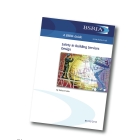Safety starts with good design

Detailed attention to future maintenance at design stage and associated health-and-safety issues can pay real dividends and avoid the hazards of litigation. Richard Tudor of WSP describes how a BSRIA guide can help.
It is important that personnel, equipment and materials get to the workface safely. In addition, employers have a legal responsibility to provide safe access/egress to any place where employees have to work, not just their normal workplace. Unfortunately, in the world of maintenance you wonder if anyone has ever seen these requirements.
BSRIA has prepared a guide to support the efforts of the building-services industry to ensure access and egress routes are sufficient in terms of space provision and loading capacity. Consideration of safe movement of maintenance staff, the handling of major plant items and the use of mechanical lifting devices is necessary when designing and new facilities or carrying out a refurbishment.
The provision for appropriate access, whether permanent or temporary, must be safe and easy to use. Once at the workface, operatives need adequate space in which to work effectively and safely and the ability to relax where work is strenuous or awkward. The guide provides advice on what those space allowances should be.
In new-build or refurbishment projects, designers need to ensure the subject is addressed and continue monitoring the provisions put in place throughout the design stages. We all know that designers can come under pressure during the design process to reduce the spatial requirements for building-services installations. Using this guide we hope you’ll be able to stand your ground and deliver buildings that are designed and installed to provide adequate space for their safe and efficient installation, maintenance and operation.
To consider access needs adequately, designers need to understand the likely installation and maintenance work required in the buildings they design. In addition there needs to be an awareness of the regulations and legislation requirements that a design may impose on the installer and end user. A design solution can often impose additional legal responsibilities, particularly in undertaking associated operation and maintenance activities. A typical example is lighting in an atrium and how lamps will be changed.
There is a vast array of health-and-safety regulations covering all types of work situations. There are many acts and regulations for which non-compliance could result in prosecution. In some cases compliance is absolute and must be observed; in others, compliance is qualified by the phrase ‘as far as is reasonably practicable’, where the risk may need to be assessed against various factors to avoid it.
What needs to be avoided is any scope for negligence claims arising from the designs we install. Negligence can be defined as failure to do something which a reasonable man would do or doing something which a reasonable man would not do. In deciding whether or not negligence has taken place, cases could be decided on a balance of probability.
• A duty of care was owed.
• The duty of care was broken.
• The person suffered harm as a result of the duty of care being broken.
Duties are placed upon clients, designers and contractors. For most projects of any size duties are also placed upon a CDM co-ordinator and a principal contractor. All these parties are required to co-operate and co-ordinate their work. The regulations emphasise the need for competence. At the time of preparing this guide the Health & Safety Executive (HSE) was undertaking a consultation to revise the Construction (Design & Management) Regulations.
It is not necessary to be formally appointed to attract designer duties under the CDM 2007 Regulations. The fact that individuals are designing something (even in the preliminary stages) means that they must have regard to foreseeable hazard elimination and risk reduction.
Designers should pay attention to the following.
• Manage the risk, focusing on the consideration of hazard elimination and risk reduction.
• Provide adequate information about any significant risks that remain.
• Give the right information to the right people, at the right time and in the right format.
• Co-ordinate your work with that of others in to ensure the health and safety of anyone carrying out or affected for the whole life of the building.
• Take into account the requirements of the Workplace (Health, Safety & Welfare) Regulations relating to the design of, and materials used in, workplaces.
If the provision of safe access is not made. the following could become issues.
• Higher risk of equipment failure when access does not allow reasonable maintenance activities.
• Higher risk of legal action being taken against employers or owners by those affected through accident or ill health caused by the adverse conditions.
• Additional costs incurred in providing adequate safe provision.
• Additional time incurred to undertake tasks.
• Additional staff or training required to undertake tasks safely.
Decisions made at the early stages of the design influence later design choices, and it may be very difficult to reverse earlier decisions. Designers need to employ the same level of importance and detail to safety for performance appointments as for detailed design. In undertaking a performance design, it is important that the design does not constrain safety of construction, operation, maintenance or future plant replacement.
It is important to regularly review the design during its development to ensure that the original assumptions are still valid and that no new significant hazards or risks have been introduced (inadvertently or otherwise).
Projects usually accrue maximum benefit when they are developed by an integrated team. Including all parties in the process of elimination of hazard and mitigation of risk will be significantly beneficial.
The guide provides a check list as a practical aid for designers on what to avoid and what to encourage. We hope you find it useful and safety in building services design improves.
Richard Tudor was principal author of BSRIA’s guide to ‘Safety in building-services design’.
The guide is available from the BSRIA online bookshop. See link below.








